Mesopotamia and Catastrophe! The Looting and Destruction of Iraq’s Past at the Royal Ontario Museum
In April 2003 the ancient site of Babylon in present day Iraq, which once housed the hanging gardens and inspired the tower of Babel, was chosen as a US military site at the onset of the US-Iraq war. The following was inevitable.
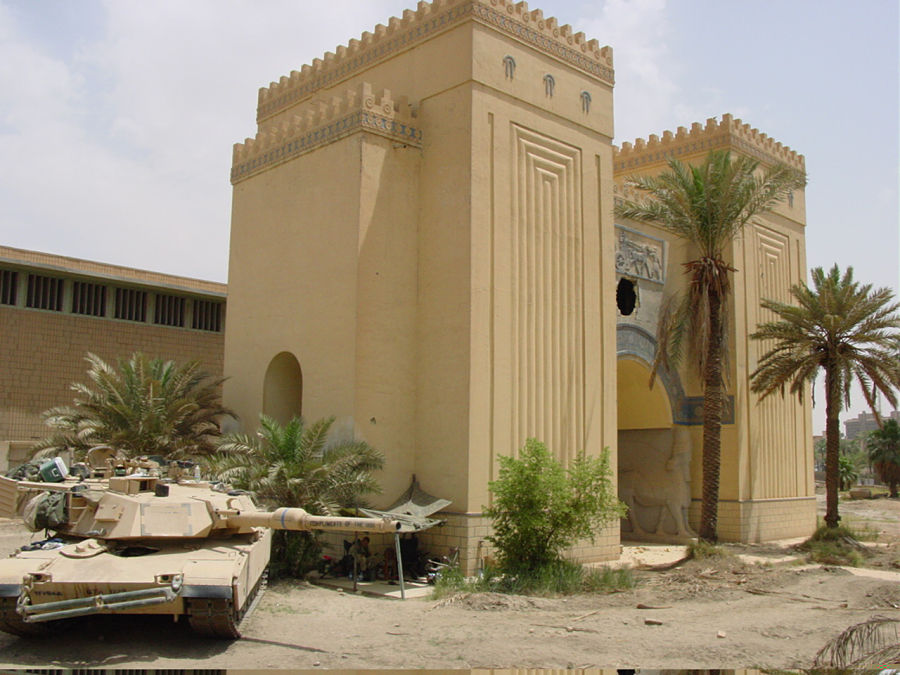 Iraq National Museum: Damage to museum’s façade. Photo: Joanne Farchakh-Bajjaly. A U.S. tank outside the children’s section of the Iraq National Museum. On April 8, 2003, a gaping hole in the façade of this gateway was made by a U.S. tank round. The Assyrian winged bull in the gateway is similar to the one on display in the Yelda Khorsabad Court in the Oriental Institute Museum. From the special companion exhibit from the Oriental Institute of the University of Chicago: Catastrophe! The Looting and Destruction of Iraq’s Past
Iraq National Museum: Damage to museum’s façade. Photo: Joanne Farchakh-Bajjaly. A U.S. tank outside the children’s section of the Iraq National Museum. On April 8, 2003, a gaping hole in the façade of this gateway was made by a U.S. tank round. The Assyrian winged bull in the gateway is similar to the one on display in the Yelda Khorsabad Court in the Oriental Institute Museum. From the special companion exhibit from the Oriental Institute of the University of Chicago: Catastrophe! The Looting and Destruction of Iraq’s Past
Destruction and looting had always been consequences of war, very much from 4000 BC, during the time of the first settlements in the region now known as Mesopotamia. But in the 21st century we regard these sites on a world heritage level, they belong to the history of our race, they are the cradle of our civilisation. This is why the British Museum’s internationally touring exhibition, Mesopotamia, with its North American premiere in the Royal Ontario Museum of Toronto, comes at a crucial time, or is it a decade too late?
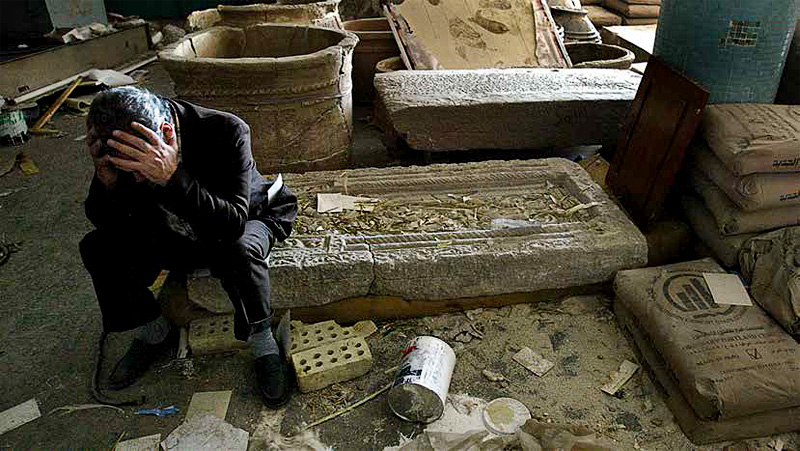 Looting. Ten years ago, looters ran wild through the Iraq National Museum. Then they moved on to ransack the country’s unrivalled array of archaeological digs, flooding global antiquities markets with irreplaceable ancient artifacts. Now—finally—experts from Iraq and around the world are returning to the scene of the crime. From the article by Clemens Reichel as it appeared in ROM Magazine, Spring 2013
Looting. Ten years ago, looters ran wild through the Iraq National Museum. Then they moved on to ransack the country’s unrivalled array of archaeological digs, flooding global antiquities markets with irreplaceable ancient artifacts. Now—finally—experts from Iraq and around the world are returning to the scene of the crime. From the article by Clemens Reichel as it appeared in ROM Magazine, Spring 2013
From June 22, 2013 to January 5, 2014, museum visitors will find themselves pleasantly surprised at the level of indebtedness we owe to the fertile land between the Tigris and Euphrates rivers (Mesopotamia translates in Greek to ‘land between rivers’). Over 3500 years have been encompassed in the exhibition. Beginning from the first urban civilisations in Sumer from about 4000 to 2000 BC, to the daunting supremacy of the Assyrian Empire, 1000 to 600 BC, and ending with the short-lived but majestic dynasty of Babylon, 600 to 540 BC. The beginnings of grand narrative writing, economy, administrative trade, and empire are only some of the focal points, with objects such as clay tablets with cuneiform inscriptions (as compared to today’s iPad tablets) and cylinder seals (the first formal signatures) scattered throughout the showrooms.
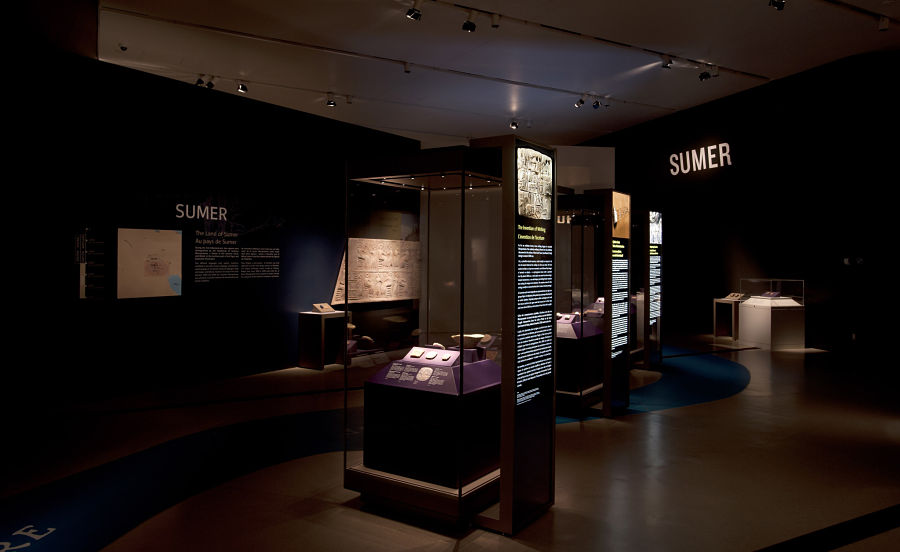 Installation view. Photo: Brian Boyle © ROM, 2013.
Installation view. Photo: Brian Boyle © ROM, 2013.
The exhibition endeavours to teach as well as entice its audience. In the Sumerian rooms from the city of Ur in southern Iraq stands a sculpture of a Ram in the Thicket on its hind legs (one of a pair from c. 2500 BC), held up by a branch to which it hopes to feed on. The modern word ‘bling’ is no-where near describing its radiance. Made of gold, lapis lazuli, shells, silver, and copper this small sculpture was once a base of a tabletop, or may have held a bowl above its head. Making it clear that luxurious objects were once used rather casually in royal homes. The archaeologist who discovered the ram as well as many more lavish grave-goods, British Leonard Woolley in 1928-9, is given a spotlight in the show.
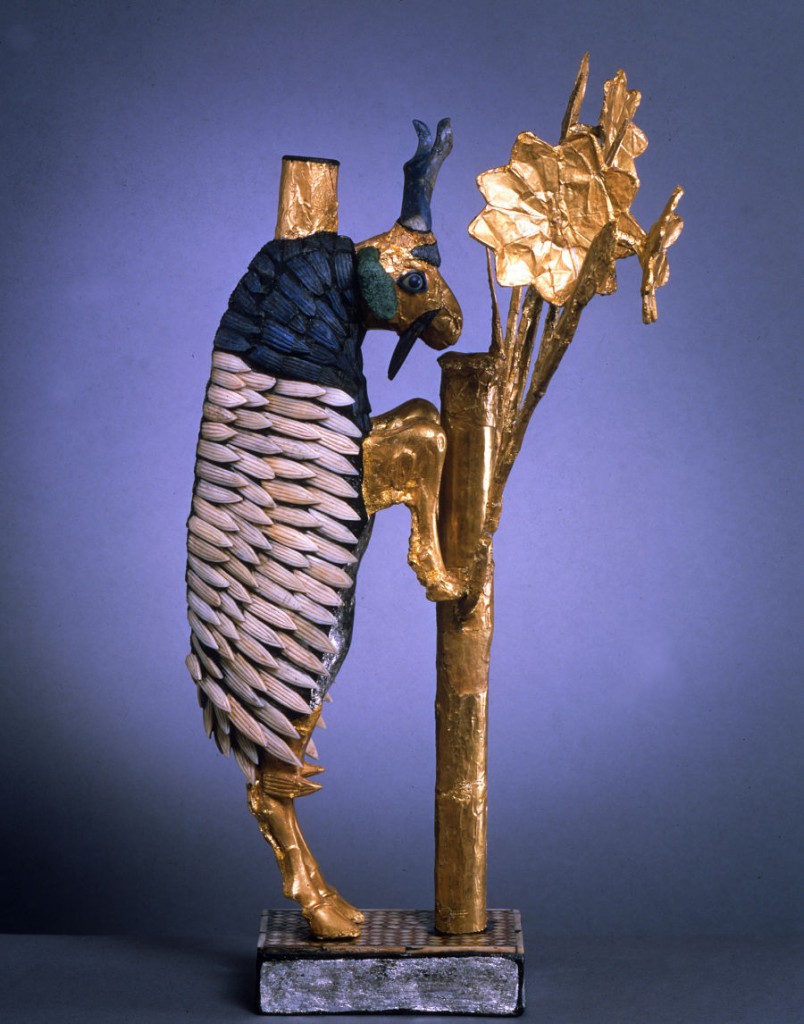 Ram in the Thicket (side view) On display for the first half of the engagement of Mesopotamia at the ROM. Gold, silver, lapis lazuli, copper, shell, red limestone, bitumen, c. 2650-2550 BCE Iraq, Ur. H: 42.5cm; W: 28cm. Section: Sumer. Courtesy of the University of Pennsylvania Museum of Archaeology and Anthropology, Philadelphia, P.A.
Ram in the Thicket (side view) On display for the first half of the engagement of Mesopotamia at the ROM. Gold, silver, lapis lazuli, copper, shell, red limestone, bitumen, c. 2650-2550 BCE Iraq, Ur. H: 42.5cm; W: 28cm. Section: Sumer. Courtesy of the University of Pennsylvania Museum of Archaeology and Anthropology, Philadelphia, P.A.
In-fact the exhibition is cram-packed with information on much of later excavators and modern interpretations of Near Eastern antiquity. It also does not shy away from describing the loss of artefacts and destruction that came about with the US invasion (as well as the previous Gulf War and WWII), through interactive videos spread across the exhibition.
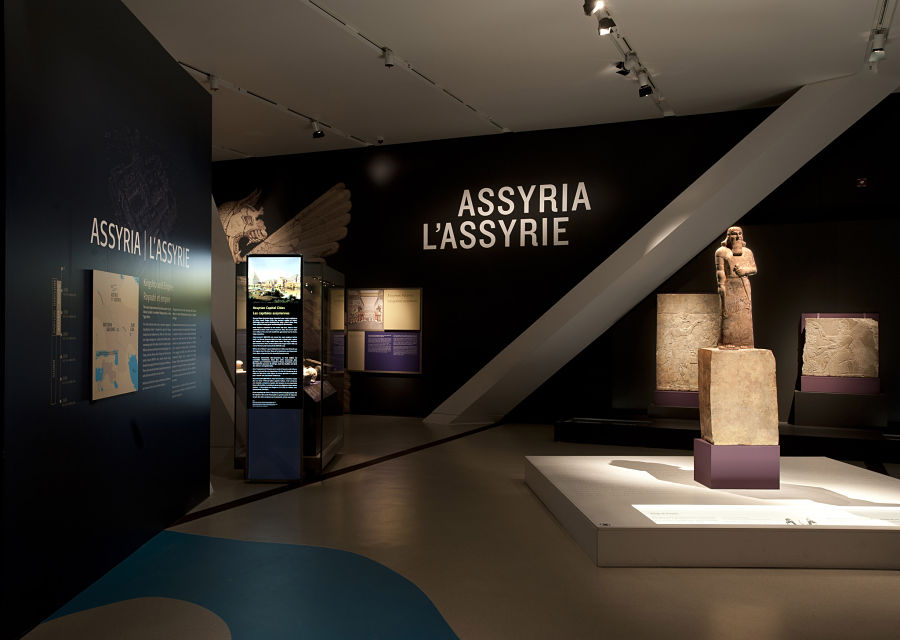 Installation view. Photo: Brian Boyle © ROM, 2013.
Installation view. Photo: Brian Boyle © ROM, 2013.
The Assyrian Empire rooms following Sumer immediately bring one word to mind, monumental. Though the largest objects from the British Museum (for example the four metered human-headed winged lions from Nimrud) could not possibly have moved, other objects stand to express the colossal stature of Assyrian palace complexes.
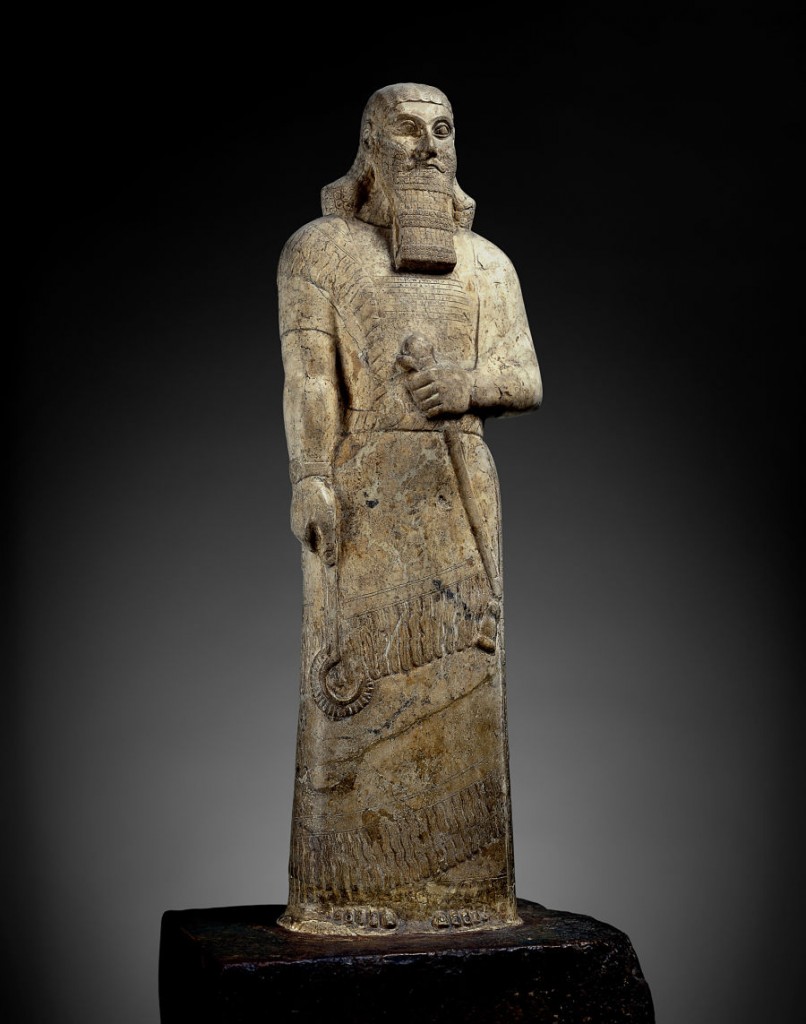 Statue of Ashurnasirpal II. Magnesite (statue), red limestone (base), Nimrud, Temple of Ishtar Sharrat-niphi 875 – 860 BCE. Statue H : 113cm, W : 32cm, D : 15cm, Base H : 77.5cm, W : 56.5cm, D : 37cm BM 118871. Section : Assyria. © The Trustees of the British Museum
Statue of Ashurnasirpal II. Magnesite (statue), red limestone (base), Nimrud, Temple of Ishtar Sharrat-niphi 875 – 860 BCE. Statue H : 113cm, W : 32cm, D : 15cm, Base H : 77.5cm, W : 56.5cm, D : 37cm BM 118871. Section : Assyria. © The Trustees of the British Museum
Other than the statue of king Ashurnasirpal II (883-859 BC), which is carved in the round, the rooms are covered with shallow limestone wall reliefs with religious, historical, and lion-hunting narratives. The most impressive and largest of these is one that depicts the Battle of Til Tuba (c. 658 BC), a massive victory for Assyria against the Iranian State of Elam (though let it be known that the Assyrians never depicted a defeat, even when sources proved otherwise). The rather perplexing and clustered storyline becomes comprehensible when used with the interactive tablets placed at either side of the relief, where separate scenes are described at a tap of the finger, including many executions by beheading.
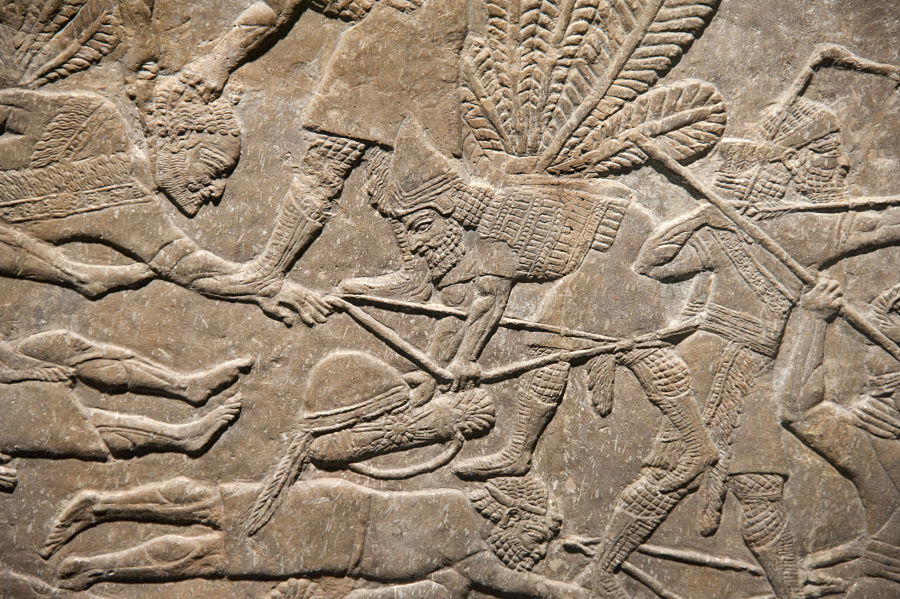 TheBattleof Til-Tuba (detail): killing and beheading of the Elamite king by Assyrian soldiers, Limestone, 660-650 BCE, Neo-Assyrian From Nineveh, Southwest Palace, Room XXXIII. From the Collections of theBritishMuseum. BM 124801. Photo: Clemens Reichel. © ROM 2013
TheBattleof Til-Tuba (detail): killing and beheading of the Elamite king by Assyrian soldiers, Limestone, 660-650 BCE, Neo-Assyrian From Nineveh, Southwest Palace, Room XXXIII. From the Collections of theBritishMuseum. BM 124801. Photo: Clemens Reichel. © ROM 2013
The final dynasty of Mesopotamia and the most widely remembered, before Persian armies followed by Alexander the Great conquered the land, was Babylon. It also stands to be the room you will never forget in the ROM’s Mesopotamia exhibition.
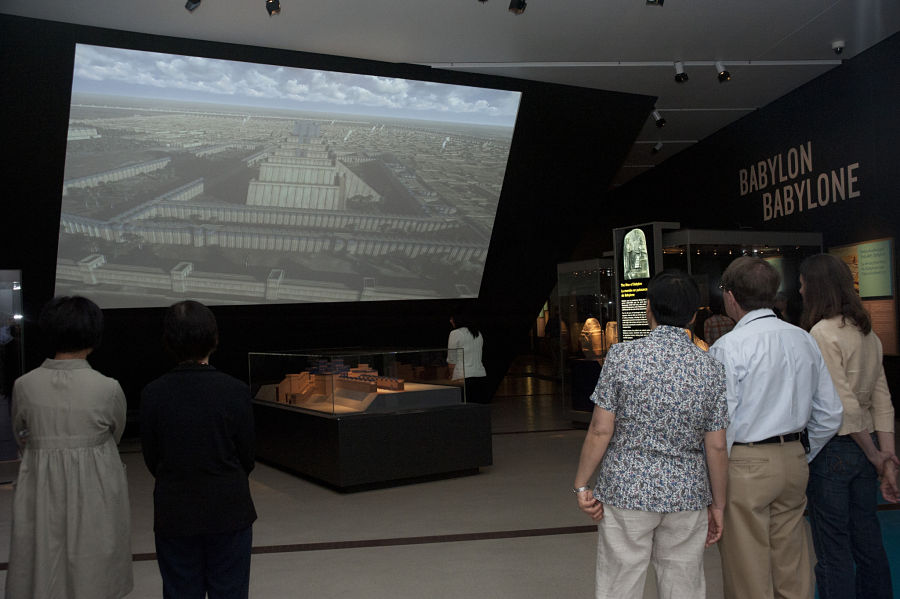 Installation view. Photo: Brian Boyle © ROM, 2013.
Installation view. Photo: Brian Boyle © ROM, 2013.
Walking in visitors find themselves across a cinematic size projection of an animation depicting what Babylon may have been like. Meticulously and elegantly produced, the looping video compliments a large model of Nebuchadnezzar’s monumental ziggurat (Mesopotamian step-pyramid complexes) where you can find the Gates of Ishtar. It was this ziggurat that inspired the story around the tower of Babel, it could well have been the tallest human structure on earth at the time, reminding us that we still have not stopped looking up.
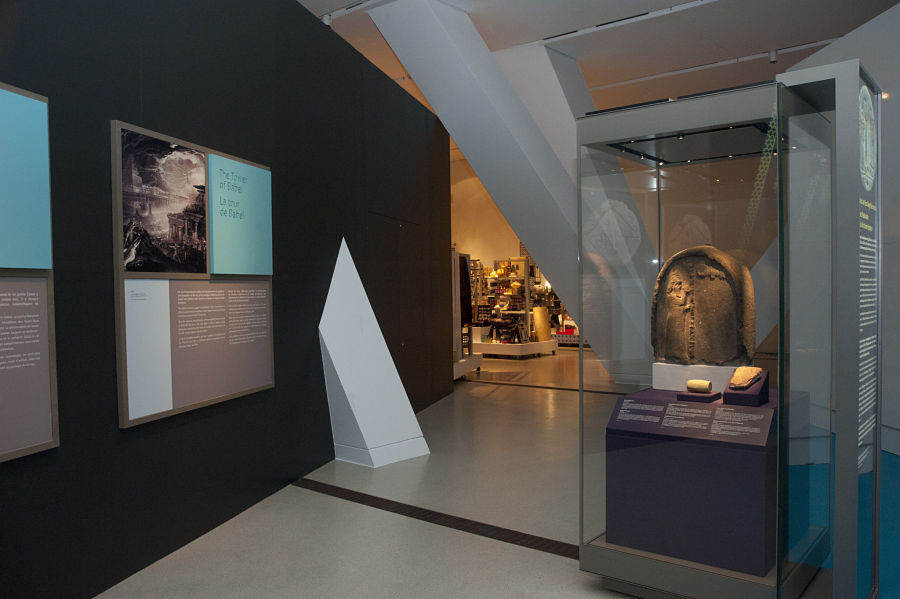 Installation view. Photo: Brian Boyle © ROM, 2013.
Installation view. Photo: Brian Boyle © ROM, 2013.
The very last panel in the exhibition brings visitors back to today, telling of the small excavations starting again in and around Iraq. As well as touching one more time upon the loss of information and history that can come with war, stating that knowledge is our only tool against it. Though your ethnic background may not necessarily come from the region of Mesopotamia, it is nevertheless their inventions and system advancements that pertain how we live today. Embrace it.
Saba Askary
*Note: The first two images are from the special exhibit from the Oriental Institute of the University of Chicago: Catastrophe! The Looting and Destruction of Iraq’s Past. It is a not part of the Mesopotamia exhibition but a separate companion show.
